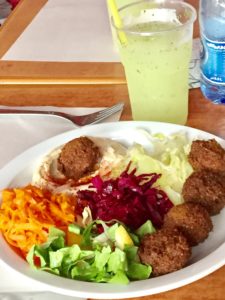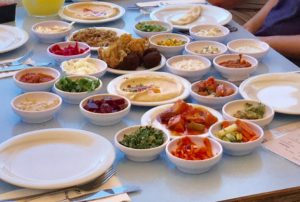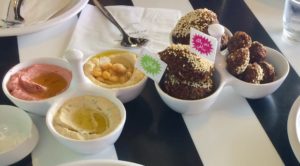Many Americans are familiar with Israeli ‘Sabra’ hummus–a brand almost ubiquitous with hummus as we know it in the states. Hummus is one of the staples of the Israeli diet, but of course, it has been consumed for generations throughout the Middle East. It is hard to capture how much better the hummus here is than what is available back home. The major difference is that hummus in Israel and the Palestinian territories is made fresh, daily and is preservative-free. Thus, it must be eaten on the first serving, and it does not store well for more than a few hours (explaining why I am ‘forced’ to lick my plate clean at each meal).

Hummus can be prepared a variety of different ways from country to country and even from town to neighborhood. Hummus is made from cooked, mashed chickpeas and blended with some combination of lemon juice, salt, garlic, olive oil, and tahini (a condiment made from sesame seeds). The ratio of ingredients differs slightly (or dramatically) from place to place as does how thickly the hummus is blended. For me, the thicker the better. My favorite traditional hummus, which I have tasted so far, I have found in Nablus, a city in the West Bank which Israelis refer to as the land of Samaria. This Palestinian hummus is very thick and served with a generous amount of locally made olive oil–so good that I had to purchase a bottle to go!

Just as the taste and texture of hummus changes from place to place so does the pita bread served with it. In the Mediterranean port city of Jaffa, thin small round slices of pita are served with hummus, along side 21 other side ‘salads’. All are served on small plates. They include plates of tahini sauce, pickled vegetables, yogurts both spicy and sweet, and many others. In a Druze neighborhood (a unique religious and ethnic minority) of the Golan Heights, I have eaten traditional hummus with ginormous pieces of thick doughy pita large enough for one to feed multiple people.
For breakfast each morning, I am served a traditional breakfast of sliced cucumbers and tomatoes, hard boiled eggs, pita bread, Greek yogurt and hummus (it’s a bit soupier than I prefer but hey-it’s still fresh hummus!) For many a lunch and dinner, I order some combination of hummus and falafel with a lamb kebab or chicken schwarma (meat placed on a spit and grilled all day long). I also order my hummus with falafel whenever I can find it. Falafel is a deep-fried ball of ground chickpeas and/or fava beans and usually drizzled with tahini sauce or lemon juice. All of these tastes compliment each other of course. Falafel can be served as small doughnut balls or as large patties.

It is easy to find simple traditional versions of hummus and falafel across this country and the greater region. Yet there are those in modern cities willing to experiment with a few twists as well. In the West Bank city of Ramallah, I was lucky enough to try a sweet pink pomegranate hummus with three kinds of falafel including one stuffed with cheese and another with fried onions, all served with a light crispy version of pita.
This diversity of ways to prepare hummus delectably demonstrates the diversity of cultures of this region and the importance of both maintaining traditional cuisines while also honoring them through experimentation that exists across Israel and Palestine.